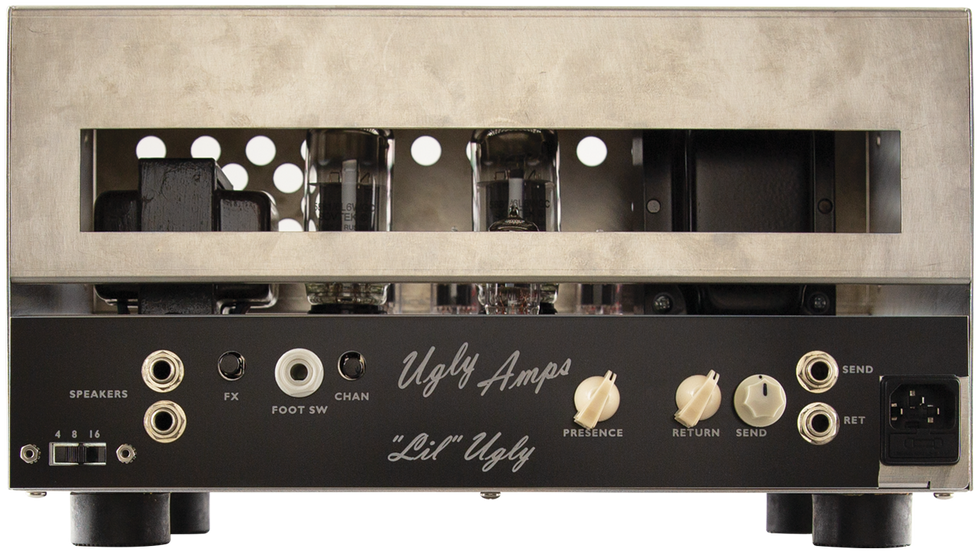In approach, if not aesthetic, Steve O'Boyle of Ugly Amps got his start much like the folks at now-defunct Analog Outfitters. Like A.O., Ugly Amps initially used parts salvaged from vintage PA systems—thus the tongue-in-cheek company name. These days, he stocks his small-batch designs with all-new parts. His latest offering, the 5881-powered, 20-watt "Lil" Ugly, puts a high-gain channel alongside a clean channel whose tones are a welcome departure from many amps in this category—all at just 12 pounds.
Home-Brew Vs. Frugal?
Visually, "Lil" Ugly's vibes veer toward spartan, even DIY. But a closer look reveals why: It packs a lot into a compact, remarkably lightweight design. Where many two-channel "lunchbox" designs sacrifice space for a shared EQ, "Lil" boasts independent controls for both. The "ugly" (dirty) side has three bands plus a mid-shift knob and a mid-boost button. The clean side, meanwhile, has bass and treble controls. Each channel has its own master and gain controls (the latter marked "volume" on the clean side). Around back are a global presence control, a series effects loop with send- and return-level knobs, dual speaker outputs (with 3-way impedance selector), a channel-selector button, a loop-engage button, and a jack for the included footswitch that controls the two latter functions.
Recorded using an Eastwood Sidejack Baritone DLX with Curtis Novak JM-HR pickups (neck, then bridge) into an Ibanez ES-2 Echo Shifter, then into "Lil" Ugly and a 2x10 cab with Celestion G10 Gold and Warehouse G10C/S speakers. Miked with a Royer R-121 feeding an Audient iD44 then into GarageBand with no EQ-ing, compression, or effects.
Construction feels solid, and the transformers are impressively hefty for an amp in this weight class. But the top corners of the folded-steel housing are just sharp enough to draw blood if you're not careful. Inside, the two large PC boards are neatly traced and wired, though the tube sockets and control pots are mounted to them rather than the chassis. Meanwhile, control pots feel well attached and appear to be chassis mounted, a factor that could affect longevity or ease and cost of repair.
Enjoyin’ the Ugly
I tested "Lil" with my baritone Eastwood Sidejack with Curtis Novak JM-WR humbuckers, routing the amp through a variety of speaker and cabinet types: a large 1x12 with a 50-watt, ceramic-magnet Weber Gray Wolf, a small 1x12 with a 35-watt alnico Celestion Ruby, and a 2x10 with a 40-watt alnico Celestion G10 Gold and a 75-watt, ceramic Warehouse G10/S. I shouldn't have been surprised at how big a difference each cab and speaker combo made, but part of it goes back to the Ugly's unique clean channel.
O'Boyle has pulled something lovely and interesting here. "Lil" cleans are fat, warm, and cushy, a little reminiscent of a lower-powered vintage Super Reverb (minus the reverb).
On many high-gain heads, especially more affordable ones, the clean channel sounds like a lower-gain version of the lead side, often yielding clinical or brittle cleans. But O'Boyle has pulled off something lovely and interesting here. "Lil" cleans are fat, warm, cushy, and a little reminiscent of a lower-powered vintage Super Reverb (minus the reverb). Because the clean channel has ample bass and leans toward the dark side, I preferred parking bass at 9 o'clock, treble at 2 o'clock, and volume (gain) at 10 o'clock for just a smidge of grit.
Given its 20-watt power rating and the fact that 5881s typically break up sooner than the 6L6s they're interchangeable with, it's no surprise that "Lil" doesn't have a lot of clean headroom. In fact, to compete with my favorite gain-channel settings, I had to push the clean master volume to max. At extreme drive-channel settings, you're unlikely to switch channels without a noticeable decibel drop or not-so-clean cleans.

Keeping the ugly channel's gain at almost 3 o'clock and master at about 11 o'clock feels like the magic recipe—availing tones seething enough for extreme metal, while ranging to Fender-y cleans in the other direction. Dirt is classically British—very Marshall-esque, but with more available saturation. Even at ferocious settings, note separation is distinct and articulation crystalline. What's more, the ugly channel responds very dynamically to pick attack, providing wide mellow-to-aggressive response without guitar-volume manipulation. To boot, the ugly channel's EQ range is generous—particularly the vast midrange, which spans honky to thin and nasal, scooped, and razor sharp.
The Verdict
Ugly Amps' "Lil" Ugly has so much going for it that the name risks undercutting its credibility. The execution may not be quite as refined as big brands, and some features might seem superfluous in big pedalboard age (presence and mid boost, for example). And the wide dirty-to-clean range mean taking extra care to find a speaker that lets both sides shine. But for the money I'm not sure there's much out there with a 1-2 punch quite like the "Lil" Ugly. Well done!



















